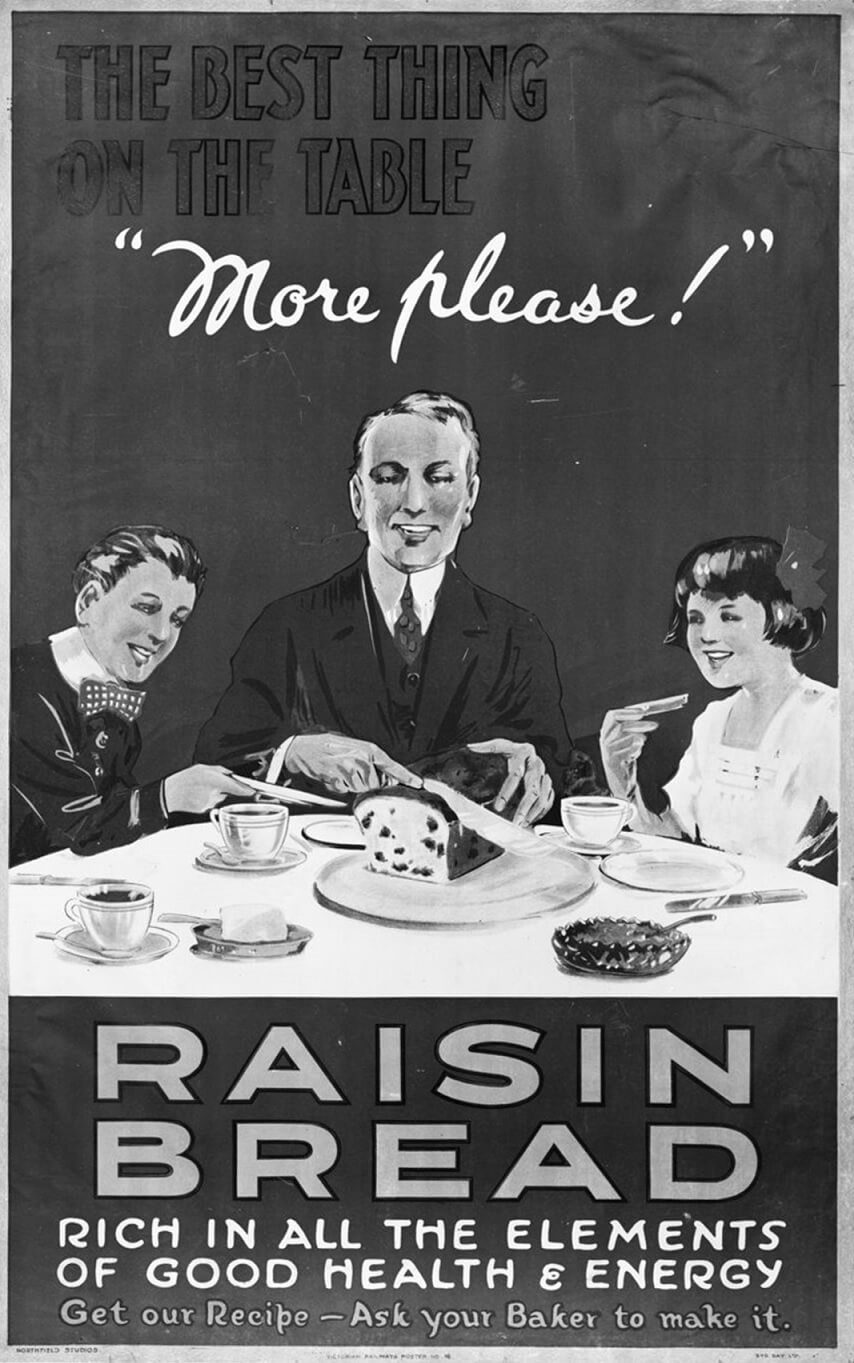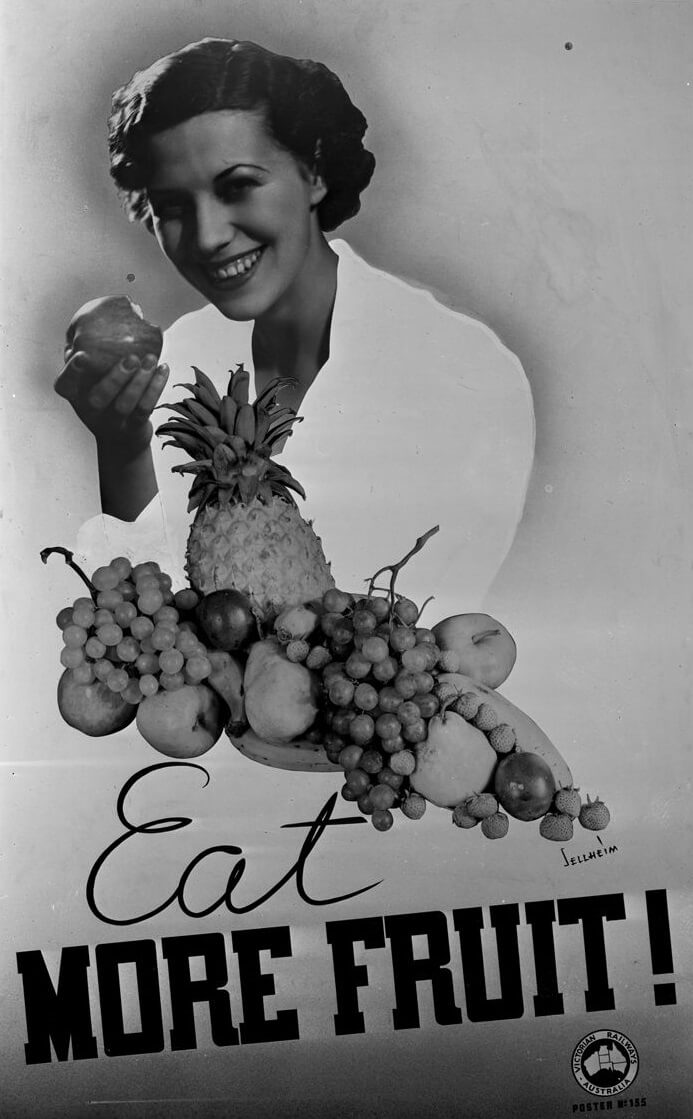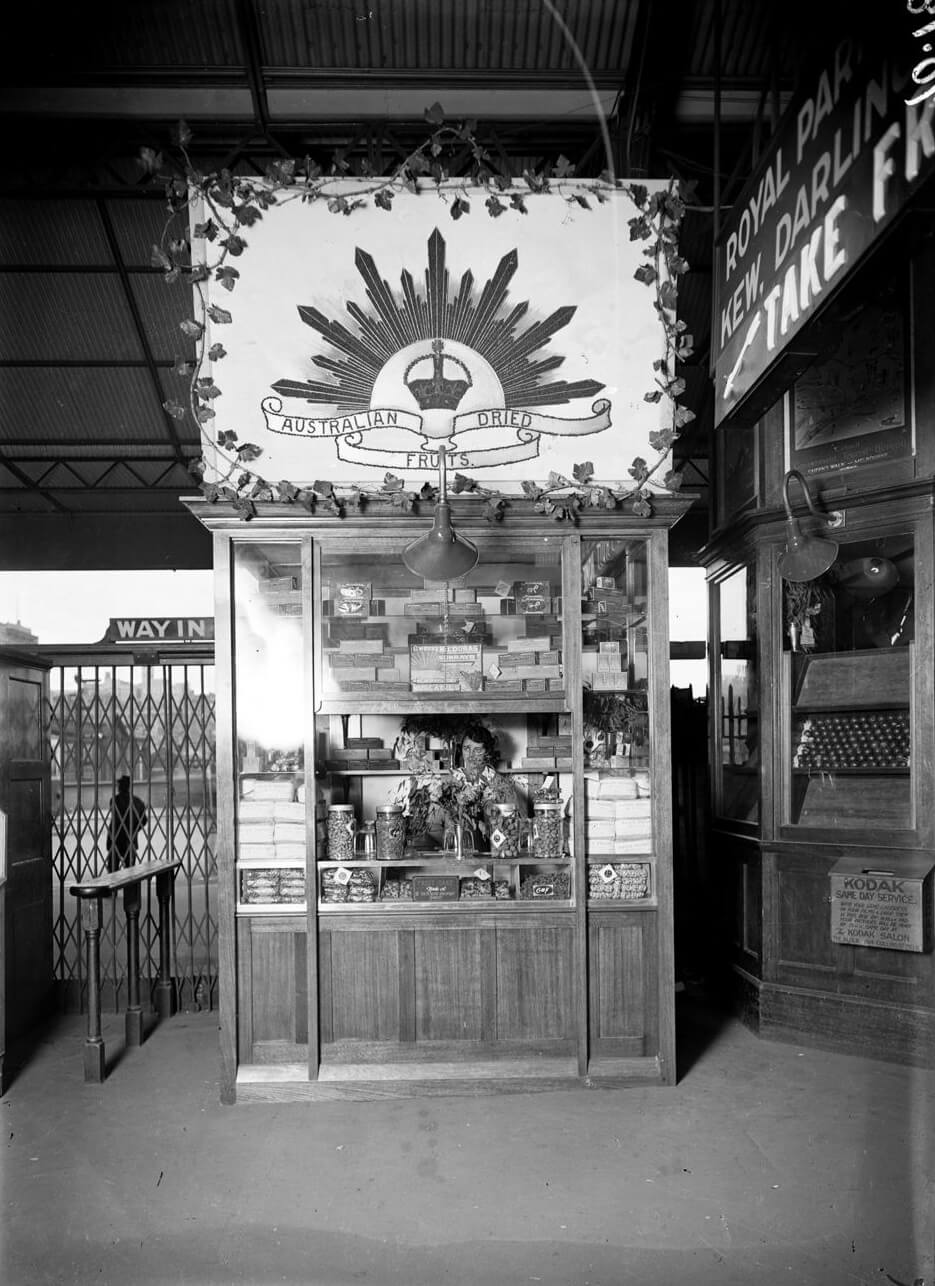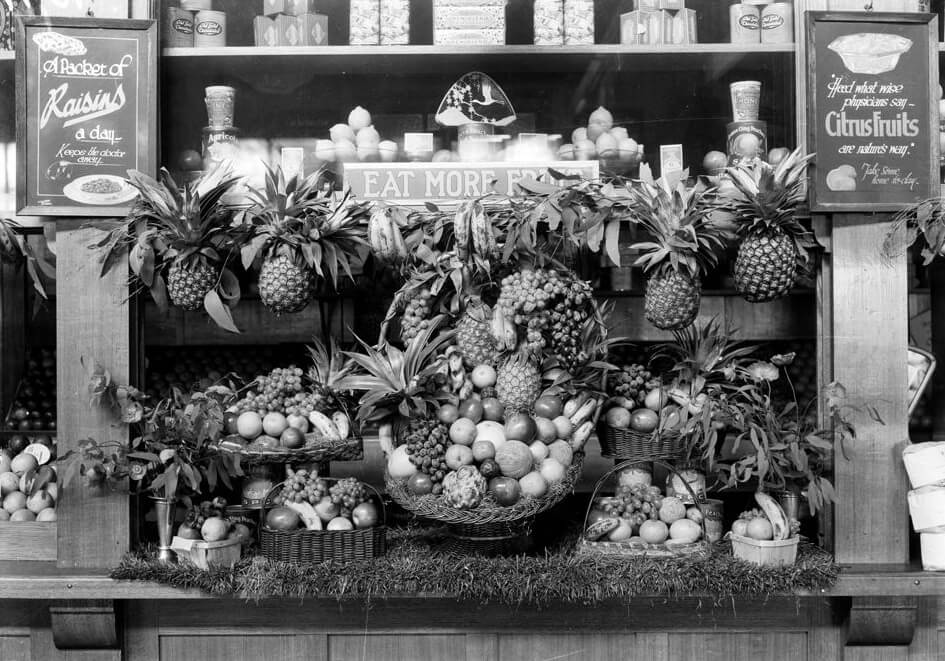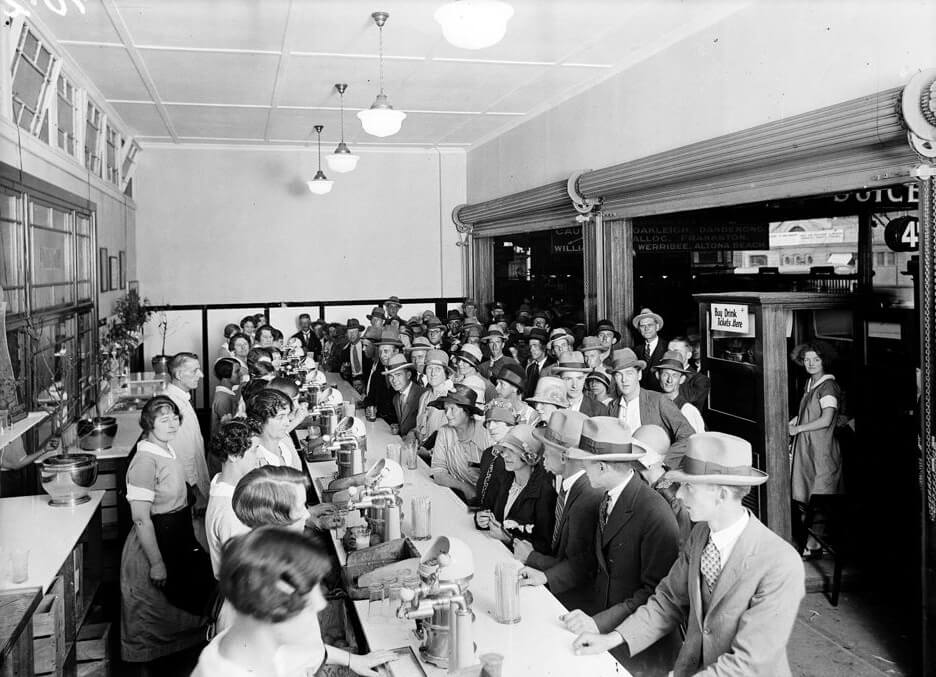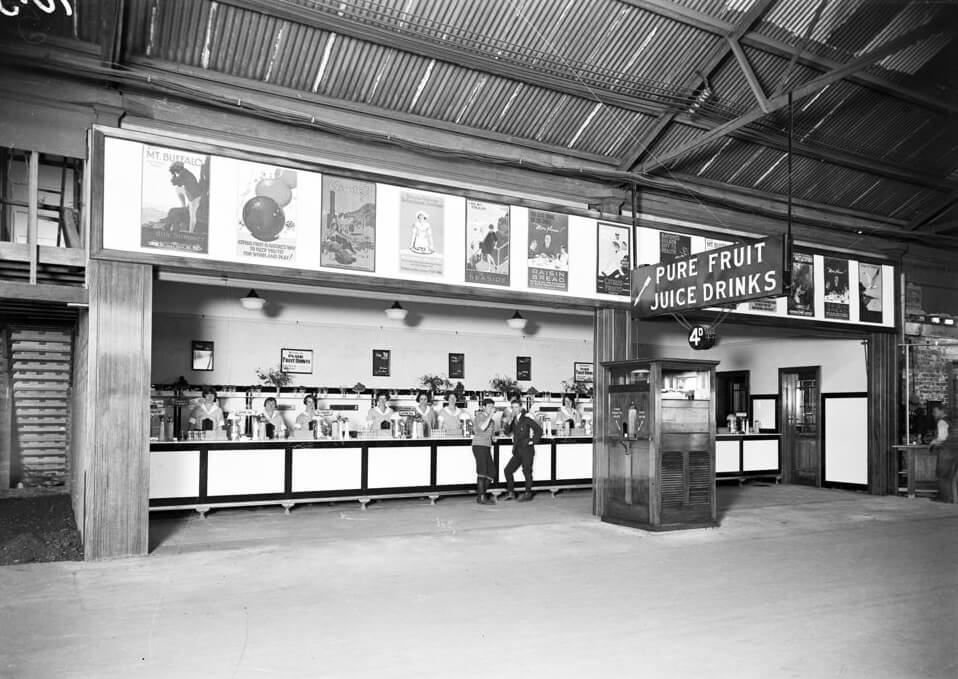Poster produced by Victorian Railways, ‘Raisin Bread, the best thing on the table’, c.1930s
Reproduced courtesy Public Record Office Victoria
Poster produced by the Victorian Railways, ‘Eat More Fruit’, by Sellheim, artist, c.1930s
Reproduced courtesy Public Record Office Victoria
The Dried Fruits Association and ourselves have had a good many talks about all the dried fruits coming in. An enormous increase will take place in the next few years in the production of raisins, and we will have to learn how to eat raisins. In California about ten years ago they had a large surplus of raisins, and some syndicate boosting California raisins went about the country with a raisin bread campaign and turned that surplus of raisins into a shortage. We ought to create a very much larger market in this country for raisins. In order to do it, the Railways are going to bake raisin bread and serve it on the dining cars. The Dried Fruits Association tells us that the master bakers will not bake it, but once the people in their homes show a desire for raisin bread then the master bakers will bake it. We ought to eat it.
Report by Chief Commissioner Clapp in the VRI Review, September1922, in Jenny Davies, Beyond the Façade: Flinders Street, more than just a railway station, 2008
A notable item produced by the Railway Bakery was raisin bread, first baked in 1923. Initially 150 loaves per day were sold in the refreshment rooms and railway stalls: one year later, they sold 1,000.
Raisin bread was the initiative of Chief Commissioner Harold Clapp, appointed Chairman of the Victorian Railway Commissioners in April 1920. Clapp initiated a clever campaign encouraging people to ‘Eat More Fruit’. Clapp realised profit for the railways would flow if producers made contact with customers. He explained: ‘If the demand for fruit can be stimulated… more will be required, consequently more will be grown, and so more transportation will be demanded.
The following report appeared in The Mail newspaper, 30 June 1923:
Mr. Clapp… will shortly take another step forward in his campaign to foster local industries. A building for the manufacture of raisin bread in Dudley Street, West Melbourne, has just been completed, and the work of tiling the interior is in progress.
At the back of the Railway Commissioner’s breadmaking scheme is an ambition to help the dry fruits industry and incidentally to increase the railway goods traffic from northern Victoria to the sea-board.
Mr Clapp believes that once the people have tasted raisin bread as the railways will manufacture… they will have no other.
As historian, Jenny Davies points out, Clapp used ‘short, pithy messages’ to promote the Eat More Fruit campaign, devising slogans such as ‘Citrus fruit is nature’s way to keep you fit for work and play’ and ‘Everyday — in Everyway RAISINS’. Posters promoting the campaign were designed and displayed throughout the rail network. And they worked. Railway patrons consumed huge quantities of fresh (and dried) fruit from Mildura, the Goulburn Valley and other fruit growing regions —all transported to Melbourne by train!
Raisin bread was particularly popular. By the late 1920s other Melbourne bakers had followed the trend set by the railways. In one report Clapp stated:
At the outset of the raisin bread campaign, only three bakers in Melbourne were manufacturing this commodity, whereas more than 100 are now undertaking its production. From this may be gauged some idea of the effect of this propaganda on the raisin consumption of the State.
Dried fruit stall, Flinders Street Station, c.1930
Reproduced courtesy Public Record Office Victoria
The railway’s recipe for raisin bread required 7 lbs. of raisins to 14 lbs. of flour. About 5,000 lbs. of raisins and 1,000 lbs. of sultanas was used weekly.
Clapp was particularly enthusiastic about dried fruit. The line to Mildura was the longest in the state and Clapp could see the profits in easily-handled freight such as citrus and raisins.
“Without railways,” Mr Clapp declared, “primary production, as we know it, would be practically impossible in Victoria. Obviously a bumper harvest is of little value unless it can be sold, and it cannot be sold unless there are adequate facilities available for transporting it to market…”
“The first ‘Eat More Fruit’ campaign”, Mr Clapp pointed out, “was begun in 1923, and since that time fruit publicity has been continuous. The results obtained have been very gratifying both to the railways and the growers. Slogans, recipe books, pictorial posters, and calico signs have been used to spread the gospel of fruit eating. Our publicity campaigns have been responsible to a large measure for growing realisation by the people of the value of fruit and other products featured in this way, and increased sales of these commodities have been reported from all parts of the country.”
Referring to the railways sales activities, he explained, “The railway fruit stalls have been increased in number, and now dispose of large quantities of fresh citrus, and other fruits, canned fruits, dried fruits, and fruit juice drinks.
Numurkah Leader, 26 January 1932. Reproduced courtesy National Library of Australia
Clapp opened the first of a chain of kiosks selling fresh fruit, dried fruit and nuts in 1923. Demand was such that stalls were placed at Prince’s Bridge and Spencer Street stations, and then suburban stations across Melbourne.
Clapp used these stalls to sell fruit in times of glut. ‘Peach Week’, for example, in January 1925, sold an extra 70 tons of Elberta peaches. Two years later, when ‘Peach Week’ became ‘Peach Fortnight’, the railways sold almost two million peaches — ‘two peaches for every man, woman and child in Melbourne.’
Fruit Juice Stall at Flinders Street Station, c.1930
Reproduced courtesy Public Record Office Victoria
In November 1926 Clapp opened a fruit juice stall at Flinders Street station. As historian, Michael Symes, describes:
Behind the counter of white vitrolite with black edging stood a line of 10 uniformed attendants, each at her Sunkist fruit juice extractor, the first in the country. Customers purchased fourpenny tickets at a cabinet, presented them at the counter and selected orange or lemon. The attendant cut the fruit, squeezed the juice and added sugar, syrup and soda from an American-looking fountain.
During the first 12 days, 44,000 drinks were squeezed — In 12 months, more than one million. By the early 1920s the railways operated 27 fruit juice stalls on its platforms and was the biggest customer of Victorian citrus growers. The Argus reported:
Dried Fruit and Citrus-growers
RED CLIFFS, Monday. – The appreciation of the Red Cliffs settlers of the co-operation of the Railways department was this morning conveyed to the chairman of the Railways Commissioners (Mr. H. W. Clapp) by Mr. G.H. Badger, representing the Australian Dried Fruits Association, and Mr G. Kitchin Kerr, for the citrus-growers. Both speakers emphasised the help that the department had given to growers in regard to the transport of fruit and the campaign for more general use by the public of citrus fruit.
Mr. Clapp said that the department was only too pleased to co-operate, for it was to their mutual advantage to work together…
Mr. Kerr said that the citrus-growers were at first not favourable to the arrangements for the reception of fruit, but they had since found that it was to their advantage, and they appreciated the placing of the fruit on the market at the proper time. If New South Wales and South Australia had a man at the head of their railways with sufficient imagination to see the importance of assisting primary producers they would be better off.
Fruit Juice Stall at Spencer Street Station, c.1930
Reproduced courtesy Public Record Office Victoria
The Victorian Railways Department is now the largest single dealer in citrus fruits in the Commonwealth. Its station fruit juice stalls are besieged by thirsty crowds, who know a good drink when they taste one.
The Chief Railways Commissioner in Victoria is the Victorian fruit growers’ best friend. Not only have his “Eat More Fruit” campaigns and departmental railway stall provision resulted in an enormously increased consumption of fruit, both fresh and dry, but his popularising of citrus drinks to the extent of capturing the imagination and palate of Melbourne’s travelling masses, has had an extraordinarily stimulating effect upon the well-being of Victoria’s fruit industry generally. Not only are citrus growers benefitting, but the popularising of the fresh fruit drink in itself constitutes an uncontemplated practical temperance reform of a permanent and far-reaching consequence.
More than 150,000 fruit drinks are sold at the Flinders Street refreshment rooms monthly. This entails the consumption of no less than 1,000 cases of oranges and 250 cases of lemons. On one hot day recently, the number of people who brought fruit drinks was 12,000.
Sixty Station Stalls.
But not only have the citrus fruit growers benefited by the department’s “Eat More Fruit” campaign. Fruit of all kinds is now sold at 60 railway stations throughout the State. It is sold at every railway refreshment room and at stalls controlled by the refreshment services branch both in town and country. Seeing that 100,000 people, representing an investment of £19,000,000, are dependent on the fruit industry, for their livelihood in Victoria, the railways distribution scheme is playing a big part in the development of the industry.
It is the success of the new Flinders Street fruit juice stall that has now caused the Commissioner to establish stalls at Prince’s Bridge and Spencer Street stations.
West Gippsland Gazette, 3 May 1927. Reproduced courtesy National Library of Australia.

